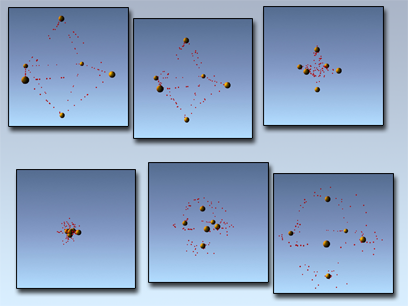You can set up particles to detect collisions with each other. This can be useful when the particles are meant to model solid objects such as marbles.

Particles colliding and then rebounding
Procedures
Example: To create particles that collide with each other:
- Create a Super Spray particle emitter, and place a Deflector space warp a short distance from it with the surface of the deflector perpendicular to the stream of the particles. Bind the deflector to the Super Spray.
- Set the Super Spray values as follows:
- Off Axis: 1, Spread: 1, Off Plane: 180, Spread: 180
- Mesh: chosen, Percent of Particles: 100
- Particle Quantity: Use Rate chosen and set to: 1
- Speed: 3, Variation: 100%
- Emit Start: 0, Emit Stop: 5, Display Until: 100, Life: 100
- Size: 4.0, Grow For: 0, Fade For: 0
- Particle Type: Sphere
- Drag the time slider so you can see the particle spheres bounce off the deflector. Note that the rebounding particles move through each other.
- On the Rotation & Collision rollout, turn on Enable in the Interparticle Collisions group. View the animation again. This time, the particles bounce off each other. Tip: InterParticle Collisions, Deflector Binding, and Bubble Noise do not get along well together. Particles may leak through the deflector when these three are used together. Instead of bubble motion use animated mapping. Use facing particles with an animated map of a bubble, where the bubble is smaller than the map size. The bubble is animated moving around the map. This simulates bubble motion at the map level.